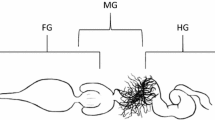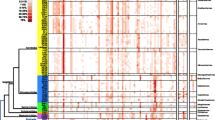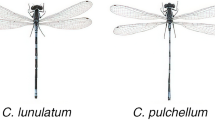Abstract
We have designed and utilized degenerate primers in the phylogenetic analysis of [FeFe] hydrogenase gene diversity in the gut ecosystems of roaches and lower termites. H2 is an important free intermediate in the breakdown of wood by termite gut microbial communities, reaching concentrations in some species exceeding those measured for any other biological system. The primers designed target with specificity the largest group of enzymatic H domain proteins previously identified in a termite gut metagenome. “Family 3” hydrogenase sequences were amplified from the guts of lower termites, Incisitermes minor, Zootermopsis nevadensis, and Reticulitermes hesperus, and two roaches, Cryptocercus punctulatus and Periplaneta americana. Subsequent analyses revealed that all termite and Cryptocercus sequences were phylogenetically distinct from non-termite-associated hydrogenases available from public databases. The abundance of unique sequence operational taxonomic units (as many as 21 from each species) underscores the previously demonstrated physiological importance of H2 to the gut ecosystems of these wood-feeding insects. The diversity of sequences observed might be reflective of multiple niches that the enzymes have been evolved to accommodate. Sequences cloned from Cryptocercus and the lower termite samples, all of which are wood feeding insects, clustered closely with one another in phylogenetic analyses to the exclusion of alleles from P. americana, an omnivorous cockroach, also cloned during this study. We present primers targeting a family of termite gut [FeFe] hydrogenases and provide results that are consistent with a pivotal role for hydrogen in the termite gut ecosystem and point toward unique evolutionary adaptations to the gut ecosystem.



Similar content being viewed by others
References
Pester M, Brune A (2007) Hydrogen is the central free intermediate during lignocellulose degradation by termite gut symbionts. ISME J 1:551–565
Brauman A, Kane MD, Labat M, Breznak JA (1992) Genesis of acetate and methane by gut bacteria of nutritionally diverse termites. Science 257:1384–1387
Breznak JA, Switzer JM (1986) Acetate synthesis from H2 plus CO2 by termite gut microbes. Appl Environ Microbiol 52:623–630
Ebert A, Brune A (1997) Hydrogen concentration profiles at the oxic-anoxic interface: a microsensor study of the hindgut of the wood-feeding lower termite Reticulitermes flavipes (Kollar). Appl Environ Microbiol 63:4039–4046
Odelson DA, Breznak JA (1985) Cellulase and other polymer-hydrolyzing activities of Trichomitopsis termopsidis, a symbiotic protozoan from termites. Appl Environ Microbiol 49:622–626
Odelson DA, Breznak JA (1985) Nutrition and growth characteristics of Trichomitopsis termopsidis, a cellulolytic protozoan from termites. Appl Environ Microbiol 49:614–621
Hoehler TM, Bebout BM, Des Marais DJ (2001) The role of microbial mats in the production of reduced gases on the early Earth. Nature 412:324–327
Schink B, Lupton FS, Zeikus JG (1983) Radioassay for hydrogenase activity in viable cells and documentation of aerobic hydrogen-consuming bacteria living in extreme environments. Appl Environ Microbiol 45:1491–1500
Scranton MI, Novelli PC, Loud PA (1984) The distribution and cycling of hydrogen gas in the waters of two anoxic marine environments. Limnol Oceanogr 29:993–1003
Sugimoto A, Fujita N (2006) Hydrogen concentrations and stable isotopic composition of methane in bubble gas observed in a natural wetland. Biogeochemistry 81:33–44
Smolenski WJ, Robinson JA (1988) In situ rumen hydrogen concentrations in steers fed eight times daily, measured using a mercury reduction detector. FEMS Microbiol Lett 53:95–100
Brune A (1998) Termite guts: the world’s smallest bioreactors. Trends Biotechnol 16:16–21
Brune A, Friedrich M (2000) Microecology of the termite gut: structure and function on a microscale. Curr Opin Microbiol 3:263–269
Leadbetter JR, Breznak JA (1996) Physiological ecology of Methanobrevibacter cuticularis sp nov and Methanobrevibacter curvatus sp nov, isolated from the hindgut of the termite Reticulitermes flavipes. Appl Environ Microbiol 62:3620–3631
Leadbetter JR, Crosby LD, Breznak JA (1998) Methanobrevibacter filiformis sp. nov, a filamentous methanogen from termite hindguts. Arch Microbiol 169:287–292
Hungate RE (1939) Experiments on the nutrition of Zootermopsis III: the anaerobic carbohydrate dissimilation by the intestinal protozoa. Ecology 20:230–245
Hungate RE (1943) Quantitative analysis on the cellulose fermentation by termite protozoa. Ann Entomol Soc Am 36:730–739
Graber JR, Leadbetter JR, Breznak JA (2004) Description of Treponema azotonutricium sp nov and Treponema primitia sp nov, the first spirochetes isolated from termite guts. Appl Environ Microbiol 70:1315–1320
Trager W (1934) The cultivation of a cellulose-digesting flagellate, Trichomonas termopsidis, and of certain other termite protozoa. Biol Bull 66:182–190
Yamin MA (1981) Cellulose metabolism by the flagellate Trichonympha from a termite is independent of endosymbiotic bacteria. Science 211:58–59
Yamin MA, Trager W (1979) Cellulolytic activity of an axenically-cultivated termite flagellate, Trichomitopsis termopsidis. J Gen Microbiol 113:417–420
Brune A (2006) Symbiotic associations between termites and prokaryotes. In: Dworkin M, Falkow S, Rosenberg E, Schleifer K-H, Stackebrandt E (eds) The prokaryotes, vol. 1. Springer Science+Business Media, New York, pp 439–474
Breznak JA (1975) Symbiotic relationships between termites and their intestinal microbiota. Symp Soc Exp Biol 29:559–580
Breznak JA (1982) Intestinal microbiota of termites and other xylophagous insects. Annu Rev Microbiol 36:323–343
Breznak JA (2000) Ecology of prokaryotic microbes in the guts of wood- and litter-feeding termites. In: Abe T, Bignell DE, Higashi M (eds) Termites: evolution, sociality, symbioses, ecology. Kluwer Academic, Boston, pp 209–231
Cleveland LR (1923) Symbiosis between termites and their intestinal protozoa. Proc Natl Acad Sci USA 9:424–428
Cleveland LR (1923) Correlation between the food and morphology of termites and the presence of intestinal protozoa. Am J Epidemiol 3:444–461
Odelson DA, Breznak JA (1983) Volatile fatty acid production by the hindgut microbiota of xylophagous termites. Appl Environ Microbiol 45:1602–1613
Leadbetter JR, Schmidt TM, Graber JR, Breznak JA (1999) Acetogenesis from H2 Plus CO2 by spirochetes from termite guts. Science 283:686–689
Sugimoto A, Bignell DE, MacDonald JA (2000) Global impact of termites on the carbon cycle and atmospheric trace gases. In: Abe T, Bignell DE, Higashi M (eds) Termites: evolution, sociality, symbioses, ecology. Kluwer Academic, Boston, pp 409–435
Frey M (2002) Hydrogenases: hydrogen-activating enzymes. ChemBioChem 3:153–160
Vignais PM, Billoud B (2007) Occurence, classification, and biological function of hydrogenases: an overview. Chem Rev 107:4206–4272
Warnecke F, Luginbühl P, Ivanova N, Ghassemian M, Richardson TH, Stege JT, Cayouette M, McHardy AC, Djordjevic G, Aboushadi N, Sorek R, Tringe SG, Podar M, Martin HG, Kunin V, Dalevi D, Madejska J, Kirton E, Platt D, Szeto E, Salamov A, Barry K, Mikhailova N, Kyrpides NC, Matson EG, Ottesen EA, Zhang X, Hernández M, Murillo C, Acosta LG, Rigoutsos I, Tamayo G, Green BD, Chang C, Rubin EM, Mathur EJ, Robertson DE, Hugenholtz P, Leadbetter JR (2007) Metagenomic and functional analysis of hindgut microbiota of a wood-feeding higher termite. Nature 450:560–565
Inward DJG, Vogler AP, Eggleton P (2007) A comprehensive phylogenetic analysis of termites (Isoptera) illuminates key aspects of their evolutionary biology. Mol Phylogenet Evol 44:953–967
Kambhampati S, Eggleton P (2000) Taxonomy and phylogeny of termites. In: Abe T, Bignell DE, Higashi M (eds) Termites: evolution, sociality, symbioses, ecology. Kluwer Academic, Boston, pp 1–23
Legendre F, Whiting MF, Bordereau C, Cancello EM, Evans TA, Grandcolas P (2008) The phylogeny of termites (Dictyoptera: Isoptera) based on mitochondrial and nuclear markers: implications for evolution of the worker and pseudergate castes, and foraging behaviors. Mol Phylogenet Evol 48:615–627
Ballor NR, Paulsen I, LeadBetter JR (2011) Genomic analysis reveals multiple [FeFe] hydrogenases and hydrogen sensors encoded by treponemes from the H2-rich termite gut. Microb Ecol doi:10.1007/s00248-011-9922-8
Inward D, Beccaloni G, Eggleton P (2007) Death of an order: a comprehensive molecular phylogenetic study confirms that termites are eusocial cockroaches. Biol Lett 3:331–335
Lo N, Tokuda G, Watanabe H, Rose H, Slaytor M, Maekawa K, Bandi C, Noda H (2000) Evidence from multiple sequences indicates that termites evolved from wood-feeding cockroaches. Curr Biol 10:801–804
Klass K-D, Nalepa C, Lo N (2008) Wood-feeding cockroaches as models for termite evolution (Insecta: Dictyoptera): Cryptocercus vs Parasphaeria boleiriana. Mol Phylogenet Evol 46:809–817
Ohkuma M, Noda H, Hongoh Y, Nalepa CA, Inoue T (2009) Inheritance and diversification of symbiotic trichonymphid flagellates from a common anscestor of termites and the cockroach Cryptocercus. Proc Biol Sci 276:239–245
Breznak JA (2006) Termite gut spirochetes. In: Radolf J, Lukehart S (eds) Pathogenic treponema: molecular and cellular biology. Caister Academic, Wymondham, pp 421–444
Noirot C (1995) The gut of termites (Isoptera): comparative anatomy, systematics, phylogeny. I. Lower termites. Ann Soc Entomol Fr 31:197–226
Lemke T, van Alen T, Hackstein JH, Brune A (2001) Cross-epithelial hydrogen transfer from the midgut compartment drives methanogenesis in the hindgut of cockroaches. Appl Environ Microbiol 67:4657–4661
Inoue J-I, Saita K, Kudo T, Ui S, Ohkuma M (2007) Hydrogen production by termite gut protists: characterization of iron hydrogenases of Parabasalian symbionts of the termite Coptotermes formosanus. Eukaryot Cell 6:1925–1932
Boyd ES, Hamilton TL, Spear JR, Lavin M, Peters JW (2010) [FeFe]-hydrogenase in Yellowstone National Park: evidence for dispersal limitation and phylogenetic niche conservatism. ISME J 4:1485–1495
Boyd ES, Spear JR, Peters JW (2009) [FeFe] hydrogenase genetic diversity provides insight into molecular adaptation in a saline microbial mat community. Appl Environ Microbiol 75:4620–4623
Matson EG, Zhang X, Leadbetter JR (2010) Selenium controls transcription of paralogous formate dehydrogenase genes in the termite gut acetogen, Treponema primitia. Environ Microbiol 12:2245–2258
Ottesen EA, Leadbetter JR (2010) Diversity of formyltetrahydrofolate synthetases in the guts of the wood-feeding cockroach Cryptocercus punctulatus and the omnivorous cockroach Periplaneta americana. Appl Environ Microbiol 76:4909–4913
Zhang X, Matson EG, Leadbeetter JR (2010) Genes for selenium dependent and independent formate dehydrogenaes in the gut microbial communities of three lower, wood-feeding termites and sa wood-feeding roach. Environ Microbiol 13:307–323
Matson EG, Ottesen EA, Leadbetter JR (2007) Extracting DNA from the gut microbes of the termite (Zootermopsis nevadensis) and visualizing gut microbes. JoVE 4. Available at http://www.jove.com/index/Details.stp?ID=195. Accessed September 2010
Combet C, Blanchet C, Geourjon C, Deléage G (2000) NPS@: network protein sequence analysis. Trends Biochem Sci 25:147–150
Nicolet Y, Piras C, Legrand P, Hatchikian CE, Fontecilla-Camps JC (1999) Desulfovibrio desulfuricans iron hydrogenase: the structure shows unusual coordination to an active site Fe binuclear center. Structure 7:13–23
Peters JW, Lanzilotta WN, Lemon BJ, Seefeldt LC (1998) X-ray crystal structure of the Fe-only hydrogenase (CpI) from Clostridium pasteurianum to 18 angstrom resolution. Science 282:1853–1858
Meyer J (2007) [FeFe] hydrogenases and their evolution: a genomic perspective. Cell Mol Life Sci 64:1063–1084
Schloss PD, Handelsman J (2005) Introducing DOTUR, a computer program for defining operational taxonomic units and estimating species richness. Appl Environ Microbiol 71:1501–1506
Vignais PM, Billoud B, Meyer J (2001) Classification and phylogeny of hydrogenases. FEMS Microbiol Rev 25:455–501
Ludwig W, Strunk O, Westram R, Richter L, Meier H, Yadhukumar BA, Lai T, Steppi S, Jobb G, Förster W, Brettske I, Gerber S, Ginhart AW, Gross O, Grumann S, Hermann S, Jost R, König A, Liss T, Lüssmann R, May M, Nonhoff B, Reichel B, Strehlow R, Stamatakis A, Stuckmann N, Vilbig A, Lenke M, Ludwig T, Bode A, Schleifer KH (2004) ARB: a software environment for sequence data. Nucleic Acids Res 32:1363–1371
Néron B, Ménager H, Maufrais C, Joly N, Maupetit J, Letort S, Carrere S, Tuffery P, Letondal C (2009) Mobyle: a new full web bioinformatics framework. Bioinformatics 25:3005–3011
Vu AT, Nguyen NC, Leadbetter JR (2004) Iron reduction in the metal-rich guts of wood-feeding termites. Geobiology 2:239–247
Schwartz E, Friedrich B (2006) The H2-Metabolizing prokaryotes. In: Dworkin M, Falkow S, Rosenberg E, Schleifer K-H, Stackebrandt E (eds) Prokaryotes, vol 2. Springer Science+Business Media, New York, pp 496–563
Soboh B, Linder D, Hedderich R (2004) A multisubunit membrane-bound [NiFe] hydrogenase and an NADH-dependent Fe-only hydrogenase in the fermenting bacterium Thermoanaerobacter tengcongensis. Microbiology 150:2451–2463
Verhagen MF, O’Rourke T, Adams MW (1999) The hypothermophylic bacterium, Thermotoga maritima, contains an unusually complex iron-hydrogenase: amino acid sequence analyses versus biochemical characterization. Biochim Biophys Acta 1412:212–229
Yang H, Schmitt-Wagner D, Stingl U, Brune A (2005) Niche heterogeneity determites bacterial community structure in the termite gut (Reticulitermes santonensis). Environ Microbiol 7:916–932
Lilburn TG, Kim KS, Ostrom NE, Byzek KR, Leadbetter JR, Breznak JA (2001) Nitrogen fixation by symbiotic and free-living spirochetes. Science 292:2495–2498
Miyata R, Noda N, Tamaki H, Kinjyo T, Aoyagi H, Uchiyama H, Tanaka H (2007) Influence of feed components on symbiotic bacterial community structure in the gut of the wood-feeding higher termite Nasutitermes takasagoensis. Biosci Biotechnol Biochem 71:1244–1251
Ottesen EA (2009) The biology and community structure of CO2-reducing acetogens in the termite hindgut. PhD dissertation, California Institute of Technology
Schmitt-Wagner D, Friedrich MW, Wagner B, Brune A (2003) Phylogenetic diversity, abundance, and axial distribution of bacteria in the intestinal tract of two soil-feeding termites (Cubitermes spp.). Appl Environ Microbiol 69:6007–6017
Tanaka H, Aoyagi H, Shina S, Doudou Y, Yoshimura T, Nakamura R, Uchiyama H (2006) Influence of the diet components on the symbiotic microorganisms community in hindgut of Coptotermes formosanus Shiraki. Appl Microbiol Biotechnol 71:907–917
Acknowledgments
This research was supported by grants from the NSF (MCB-0523267) and the DOE (DE-FG02-07ER64484) and by an NSF Graduate Student Research Fellowship (to NRB). We would like to thank our laboratory colleagues and several anonymous reviewers for their insightful comments during the preparation of this manuscript.
Author information
Authors and Affiliations
Corresponding author
Electronic Supplementary Material
Below is the link to the electronic supplementary material.
Figure S1
Maximum likelihood tree of all cloned family 3 [FeFe] hydrogenase sequences. The tree was calculated using a maximum likelihood (Phylip ProML) method with 173 unambiguously aligned amino acid positions. Open circles designate groupings also supported by either parsimony (Phylip PROTPARS, 1,000 bootstraps) or distance matrix (Fitch) methods. Closed circles designate groupings supported by all three methods. Hydrogenase sequences taken from T. primitia ZAS-2 and T. primitia ZAS-9 are labeled as ZAS-2 (HndA1) and ZAS-9 (HndA), respectively. The sequence labeled as Metagenome corresponds to the sequence with the gene identifier 2004084376 taken from a termite hindgut metagenome sequence [33]. Outgroup sequences are listed in the “Methods” section of the main text. (JPEG 608 kb)
Figure S2
Phylogram of family 3 [FeFe] hydrogenases cloned from the guts of an adult and nymph C. punctulatus samples. The tree was calculated using a maximum likelihood (Phylip ProML) method with 173 unambiguously aligned amino acid positions. Open circles designate groupings also supported by either parsimony (Phylip PROTPARS, 1,000 bootstraps) or distance matrix (Fitch) methods. Closed circles designate groupings supported by all three methods. All sequences cloned from P. americana are highlighted by a gray box. Outgroup sequences are listed in the “Methods” section of the main text. (JPEG 264 kb)
Table S1
OTUs calculated using the furthest-neighbor method in DOTUR (Schloss & Handelsman, 2005) with a 97% amino-acid similarity cut-off. Number of cloned sequences grouped within each OTU. Percent of cloned sequences represented by each OTU within a gut sample. §Sequences that could not be classified as belonging to any of the sequence families defined by Warnecke et al. [33]. Sequence classified as belonging to the Family 7 hydrogenase sequence family defined by Warnecke et al. [33]. (PDF 459 kb)
Rights and permissions
About this article
Cite this article
Ballor, N.R., Leadbetter, J.R. Analysis of Extensive [FeFe] Hydrogenase Gene Diversity Within the Gut Microbiota of Insects Representing Five Families of Dictyoptera. Microb Ecol 63, 586–595 (2012). https://doi.org/10.1007/s00248-011-9941-5
Received:
Accepted:
Published:
Issue Date:
DOI: https://doi.org/10.1007/s00248-011-9941-5




